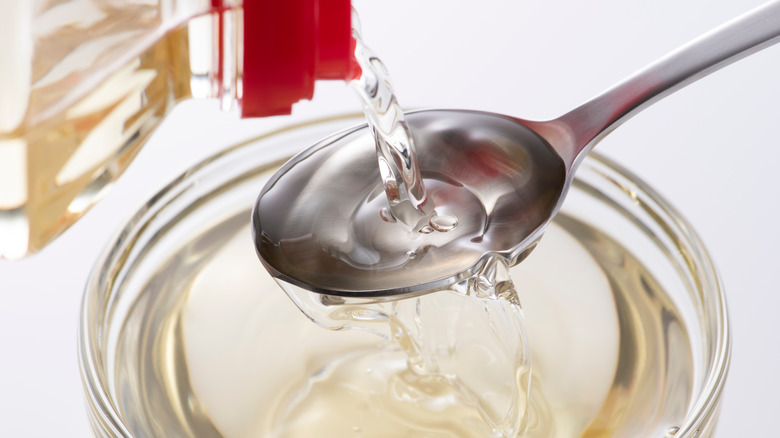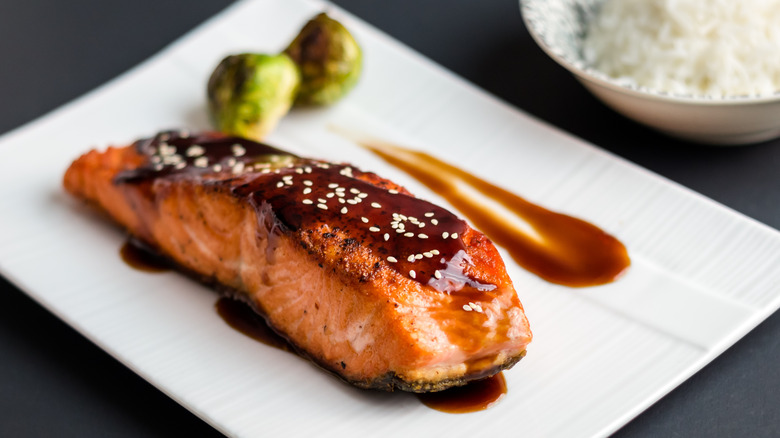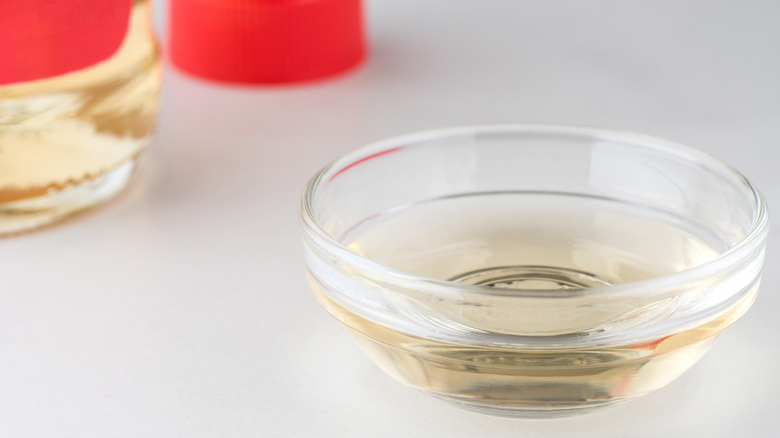The Best Substitutes For Mirin That You Should Have In Stock
If you wander along the aisle of an Asian supermarket, you may spot a bottle of mirin next to a bottle of rice vinegar. This Japanese sweet alcoholic seasoning is made by fermenting a combination of steamed glutinous rice, and koji (cultured rice), in a bit of shochu (distilled rice or sweet potato liquor). Even if you never used it in your cooking, chances are you have tasted mirin in many Japanese dishes — notably in salmon teriyaki or sushi — to give it a sweet-tangy taste.
During the 40-60 day fermentation period, the starch in the rice breaks down, which creates sugar, acid, and organic acid. The more traditional Hon-mirin, which is comprised of similar ingredients but uses shochu instead of sake, contains up to 14% alcohol, and in Japan it is classified as alcohol. The mirin bottles that are sold in supermarkets are not hon-mirin; instead, they are more likely to be labeled "aji-mirin" (which translates to "tastes like mirin"), with 8-14% alcohol and additional sweeteners.
If you're cooking and realize you do not have any kind of mirin on hand, fear not. There are a few substitution options, using sweet-acidic combinations like rice vinegar and sugar, or sake and sugar.
Experiment to find the right balance of sweet and tangy taste
It is helpful to first understand mirin's taste in relation to other products. Mirin is similar to sake, but has more sugar and a lower alcohol content. Despite the cursory similarities to rice vinegar, mirin has a sweeter taste profile compared to the acidic taste of rice vinegar.
With this, there is no obvious one-to-one substitution for mirin, although a dry sherry or a sweet marsala wine could do the trick. The closest substitution options are a combination of sweet and acidic or tangy condiment to mirror the taste profile of mirin. Rice vinegar and sugar is an easy option, using about ½ teaspoon sugar per tablespoon of vinegar.
Sake and sugar are also possible options, although not everyone might be game to use their bottle of sake in chicken teriyaki. The ratio of sake and sugar comes down to personal preference and the type of sake. Selected types of unfiltered sake might be sweet enough to use as a mirin substitute, but oftentimes a sweetener will be needed. Some chefs recommend three parts sake to one part sugar, although there are some recipes that recommend equal parts of sake and sugar.
The suggestions above stick with rice based substitutes. However, other combinations can also work, like white wine and sugar; or for non alcoholic options, try apple juice and sugar.
Use mirin and substitutes to create depths of flavor
Since mirin contains sugar, it adds a shiny film and luster to food, which is especially noticeable in sauces and glaze. It also balances the flavor of savory food, which is why it is often paired with soy sauce. One of the common uses for mirin is to combine it with soy sauce and sugar to make teriyaki sauce, which is a versatile sauce you can top on salmon, chicken, or vegetables.
If you are substituting mirin with something that you readily have on hand, use the same amount of substitute as you would use mirin in the recipe, but be prepared to adjust the other ingredients as needed. For example, if you're using rice vinegar and sugar as a mirin substitute for teriyaki sauce, you may not need to heap on more sugar.
The other thing to note is that alcohol substitutes like sake or white wine need to be cooked off before serving. This likely means you may have to cook the dish for longer than the recipe suggests. Alternatively, consider making mirin your pantry staple. It takes over a year for mirin to go bad, but it can lose its potency and flavor after a few months.


